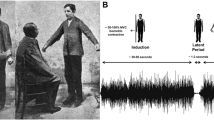Abstract
The author holds the opinion that the so-called operant, or instrumental, conditional reflexes, in spite of differences in specific features, do not differ in principle from classical conditional reflexes, and therefore they should not be opposed to them, or be placed in a special or separate group. In support of this opinion, this paper presents data which show that:
-
1.
In the establishment of classical and operant conditional reflexes, two-way conditional connections—direct and reverse—are formed.
-
2.
Each conditional reflex may be considered to be the activity of a direct or reverse conditional connection. Each is a copy of the homogeneous unconditional reflex and is accomplished by the same anatomic structures, in the same functional way.
-
3.
In principle, the functional architecture of the defensive operant conditional reflexes has the same features as the functional architecture of the food conditional reflexes. However, the elaboration of the defensive conditional reflex counteracts the action of the unconditional reflex.
Similar content being viewed by others
References
Aslanova, I. F., Joffe, M. E., and Samoilov, M. I.: M.D.D. (Russian), Moscow, 1966, p. 222.
Asratyan, E. A.: Brain Reflexes (Russian), Moscow, 1966.
Asratyan, E. A.:Higher Nervous Activity,16: 577, 1966.
Asratyan, E. A.: Nervous Mechanisms of Motor Activity (Russian), 1966, p. 329.
Asratyan, E. A.: Brain Mechanisms and Learning, Oxford, 1961, p. 95.
Gasanova, R. L., Ivanova, N. G., and Kozlovskaya, I. B.: N.M.D.D. (Russian), Moscow, 1966, p. 339.
Kimble, C. A.: Conditioning and Learning, (Hilgard and Marquis), revised. New York: Appleton Century Crofts, Inc., 1961.
Konorski, I.: Conditioned Reflex and Neuron Organization. Cambridge, 1948.
Konorski, I.:Acta Biol. Exper.,24:59, 1964.
Miller, N. E.: Experiments Relative to Learning, Theory and Psychology. Moscow, 1966.
Pavlov, I. P.: Lectures on Conditional Reflexes, trans. and ed. by W. Horsley Gantt. New York, International Publishers, 1928.
Thorndike, E. L.: Animal Intelligence—An Experimental Study of the Associative Processes in Animals. Psychol. Monogr. 2, no. 8, 1898.
Vasiljeva, O. N., and Popova, E. I.: N. M. D. D. (Russian), Moscow. 1966, p. 352.
Additional information
Professor Asratyan is a pupil of Pavlov's who worked in Pavlov's laboratory at the Academy of Sciences, Leningrad, in the late 1920's. He is at present in Moscow. He is a member of the Academy of Sciences of the U. S. S. R. (founded in 1625 by Peter the Great).
Rights and permissions
About this article
Cite this article
Asratyan, E.A. The functional architecture of instrumental conditional reflexes. Conditional Reflex 2, 258–272 (1967). https://doi.org/10.1007/BF03034124
Issue Date:
DOI: https://doi.org/10.1007/BF03034124




